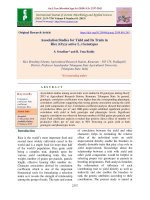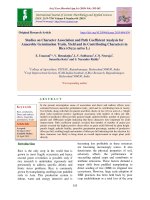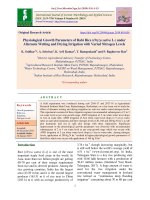Association studies for yield components, physico-chemical and nutritional quality parameters in colored rice (Oryza sativa L.)
Bạn đang xem bản rút gọn của tài liệu. Xem và tải ngay bản đầy đủ của tài liệu tại đây (328.56 KB, 7 trang )
Int.J.Curr.Microbiol.App.Sci (2019) 8(6): 359-365
International Journal of Current Microbiology and Applied Sciences
ISSN: 2319-7706 Volume 8 Number 06 (2019)
Journal homepage:
Original Research Article
/>
Association Studies for Yield Components, Physico-chemical and
Nutritional Quality Parameters in Colored Rice (Oryza sativa L.)
P. Sri Devi*, B. Krishna Veni, D.P.B. Jyothula and D. Sandeep Raja
Dept. of Genetics& Plant Breeding, Agriculture College, Bapatla,
Guntur (Dt), Andhra Pradesh, India
*Corresponding author
ABSTRACT
Keywords
Character
association, Path
analysis, Yield,
Quality traits
Article Info
Accepted:
04 May 2019
Available Online:
10 June 2019
The present study was undertaken with an objective to determine the degree
of association and magnitude of direct and indirect effects between grain
yield and other yield components, physico-chemical & nutritional quality
traits. Character association studies revealed that panicle length and test
weight showed significant positive correlation while days to 50%
flowering, alkali spreading value and L/B ratio exhibited significant
negative relationship with grain yield/plant. Test weight followed by
spikelet fertility percentage and panicle length manifested positive direct
effects on grain yield/plant.
Nowadays, whole grain pigmented rice has
been categorized as one of the potent
functional foods since it contains high
amounts of phenolic compounds (Yawadio et
al., 2007). In addition, colored rice contains
higher levels of proteins, vitamins and
minerals than common white rice while red
rice is good source of fibre, antioxidants,
magnesium and iron. Yield is a complex
character and dependent on many component
traits. Hence, in the present study an attempt
was made to study the association between
yield and yield contributing characters and
quality traits along with direct and indirect
effects of yield attributing characters and
quality traits on grain yield.
Introduction
Rice (Oryza sativa L.) is one of the most
important cereal crops in tropics as well as
parts of temperate regions in the world. It is
the staple food of more than three billion
people (Bhattacharjee et al., 2002) in 39
countries that comprises of nearly half of the
world’s population. Rice is the only cereal,
cooked and consumed as a whole grain and
quality considerations are much more
important than for any other food crops
(Hossain et al., 2009). Increased income
levels and self-sufficiency induced rice
availability for consumption has brought a
shift in the consumer as well as market
preferences for better grain quality.
359
Int.J.Curr.Microbiol.App.Sci (2019) 8(6): 359-365
(1959) was used to calculate the direct and
indirect contribution of various traits on grain
yield.
Materials and Methods
The experiment was carried out during
Kharif, 2017 at Agricultural College Farm,
Bapatla, Andhra Pradesh. The experimental
material consisted of 26 released/advanced
genotypes developed at Agricultural Research
Station, Bapatla and the varieties released
from ARS Pattambi, Kerala. Among the 26
genotypes studied seven had normal light
brown pericarp color (BPT 5204, BPT 2270,
BPT 2295, BPT 2782, BPT 2595, BPT 2660
and BPT 2776), eight genotypes possess red
pericarp
color
(Aathira,
Samyuktha,
MattaTriveni, Jyothi, BPT 3111, Annapurna,
Harsha and BPT 3139) and the remaining had
black/purple pericarp. These genotypes were
evaluated in randomized block design with
three replications under dry direct sowing by
following manual dibbling method. Each
treatment was represented by 5 rows of 3m
length in each replication with a spacing of
20cm between rows and 15cm between
plants. All recommended cultural practices
were followed for raising the crop.
Observations were recorded on ten plants
selected at random per genotype per
replication on 18 yield and quality traits viz.,
days to 50% flowering, panicle length (cm),
plant height (cm), ear bearing tillers per plant,
grain yield per plant (g), test weight (g),
number of filled grains per panicle, total
number of grains per panicle, spikelet fertility
(%,) solid loss, water uptake, volume
expansion ratio, alkali spreading value,
length/breadth ratio, amylose content (%),
protein content, Zinc content and Fe content.
The dehusked samples were utilized for
estimation of quality parameters by following
standard procedures delineated by Little et al.,
(1958), DRR (2006), Sidhu et al., (1975) and
Juliano (1971). Phenotypic and genotypic
correlations were worked out by using the
formulae suggested by Falconer (1964). Path
coefficient analysis suggested by Wright
(1921) and elaborated by Dewey and Lu
Results and Discussion
The phenotypic and genotypic correlation
coefficients of different yield components and
quality parameters were given in table 1.
Among the yield components, ear bearing
tillers (0.424** &0.498**) and panicle length
(0.277** & 0.358**) exhibited positive and
significant association with grain yield/plant
while days to 50% flowering (-0.469** & 0.582**) manifested negative and significant
relationship suggesting that among the
material under study, the genotypes which
flowered earlier recorded higher grain
yield/plant,
These results were in accordance with the
findings of Bhati et al., (2015) and
Chowdhury et al., (2016). Days to 50%
flowering recorded negative association with
plant height and test weight while it’s
association with ear bearing tillers was
positive and significant (0.380** and
0.750**) indicating that the genotypes which
flowered earlier recorded more ear bearing
tillers and also possessed slender grain.
Sharma and Sharma also reported similar
findings.
The trait panicle length manifested significant
and positive relationship with filled
grains/panicle (0.340 and 0.450**), total
grains/panicle (0.340** and 0.420**) and
spikelet fertility percentage (0.364 and
0.420**) both at phenotypic and genotypic
levels respectively suggesting that the
genotypes with longer panicle accommodated
more number of grains as well as more
number of filled spikelets/panicle. These
results are in corroboration with the findings
of Veni et al., (2013).
.
360
Int.J.Curr.Microbiol.App.Sci (2019) 8(6): 359-365
Table.1 Estimates of phenotypic & genotypic correlation coefficients among yield, yield components and
quality traits in rice (Oryza sativa L.)
Fe
-0.300**
GY
-0.469**
-0.530**
-0.230*
0.750**
-0.660**
0.014
0.015
0.005
0.070
0.400**
0.280*
0.570**
0.450**
0.025
-0.81**
-0.390**
G 1.000
**
**
**
**
**
**
**
1.000
0.360
-0.220
0.033
0.340
0.340
0.064
0.300
-0.180
-0.390
-0.066
0.012
-0.170
0.330
0.240*
PL
P
**
**
**
**
**
**
*
**
**
1.000
0.510
-0.510
0.000
0.450
0.420
0.420
0.360
-0.220
-0.480
-0.091
-0.063
-0.210
0.440
0.240*
G
1.000
-0.320**
0.240*
-0.002
-0.020
0.095
0.110
0.082
-0.160
-0.42**
0.100
0.036
0.140
0.100
PH
P
1.000
-0.400**
0.290**
-0.004
-0.035
0.220*
0.120
0.090
-0.190
-0.54**
0.090
0.043
0.180
0.150
G
1.000
-0.310**
-0.021
-0.008
-0.065
0.031
0.200
0.270*
0.120
0.110
0.048
-0.36**
-0.180
EBT
P
1.000
-0.510**
-0.087
-0.097
0.110
0.076
0.330**
0.530**
0.350**
0.140
0.111
-0.61**
-0.290*
G
1.000
-0.320**
-0.320**
-0.11
-0.220*
-0.230*
-0.170
-0.64**
-0.380**
0.270*
0.330**
0.180
TW
P
1.000
-0.370**
-0.390**
-0.100
-0.230*
-0.230*
-0.180
-0.77**
-0.550**
0.300**
0.360**
0.200
G
1.000
0.980**
0.380**
0.230*
-0.055
-0.075
0.180
0.130
-0.064
0.130
0.080
FGP
P
1.000
0.990**
0.58**
0.260*
-0.0610
-0.120
0.310**
0.180
-0.100
0.180
0.150
G
1.000
0.240*
0.180
-0.038
-0.099
0.170
0.130
-0.066
0.130
0.086
TGP
P
1.000
0.500**
0.200
-0.039
-0.140
0.320**
0.150
-0.100
0.170
0.150
G
1.000
0.350**
-0.152
0.140
0.067
0.040
-0.021
0.052
-0.012
SF %
P
1.000
0.610**
-0.280*
0.180
0.066
0.360**
-0.110
0.110
0.110
G
1.000
0.026
-0.250*
0.072
-0.025
-0.120
0.008
-0.003
SL
P
1.000
0.034
-0.290**
0.086
-0.032
-0.130
0.010
-0.007
G
1.000
0.190
0.150
0.290*
-0.170
-0.110
-0.140
WU
P
1.000
0.230*
0.190
0.390**
-0.180
-0.120
-0.160
G
1.000
0.080
0.260*
-0.088
-0.004
-0.042
VER
P
1.000
0.079
0.400**
-0.100
0.000
-0.048
G
1.000
0.110
-0.38**
-0.30**
-0.140
ASV
P
1.000
0.650**
-0.40**
-0.36**
-0.230*
G
1.000
-0.150
-0.025
-0.060
L/B
P
1.000
-0.210
-0.066
-0.120
G
1.000
-0.127
0.184
AC
P
1.000
-0.154
0.227*
G
0.405**
0.282*
P
**
0.423
0.338**
PC
G
1.000
0.321**
Zn
P
1.000
0.415**
G
1.000
P
1.000
Fe
G
Significant at 5% level, ** Significant at 1% level
DFF: Days to 50%floweing; PL: Paniclelength; PH: Plant height; EBT:Ear bearing tillers; TW:Test weight; FGP: Filled grains per panicle;, TGP: Total number of grains per panicle, SF %: Spikelet fertility (%:); SL:
Solid loss; WU: Water uptake; VER: Volume expansion ratio; ASV: Alkali spreading value; L/B: L/B ratio; AC: Amylose content; PC: Protein content; Zn: Zinc content; Fe: Iron content; GY: Grain yield per plant
-0.582**
0.277*
0.358**
0.161
0.145
-0.003
0.115
0.424**
0.498**
-0.037
-0.079
-0.068
-0.114
0.161
0.216
0.029
0.036
-0.201
-0.226*
0.0003
0.033
-0.264*
-0.383**
-0.224*
-0.306**
0.064
0.075
0.490**
0.558**
0.290*
0.345**
0.211
0.282*
DFF
P
DFF
1.000
PL
-0.380**
PH
-0.190
EBT
0.380**
TW
-0.600**
FGP
-0.030
TGP
-0.020
SF(%)
-0.089
SL
0.063
361
WU
0.370**
VER
0.220*
ASV
0.440**
L/B
0.340**
AC
0.018
PC
0.420**
-0.45**
0.190
0.230*
0.220*
0.240*
-0.150
-0.280*
0.240*
0.250*
-0.039
-0.035
-0.060
-0.060
0.082
0.150
0.470**
0.480**
-0.060
-0.061
-0.180
-0.190
-0.210
-0.250*
-0.044
-0.062
0.038
0.043
1.000
1.000
Zn
-0.70**
Int.J.Curr.Microbiol.App.Sci (2019) 8(6): 359-365
Table.2 Direct and indirect effects of yield components and quality traits on grain yield
among colored genotypes of rice (Oryza sativa L.)
Character
DFF
PL
PH
EBT
TW
FGP
TGP
SF (%)
SL
DFF
0.016
-0.006
PL
-0.135
0.351
PH
0.001
EBT
TW
FGP
WU
VER
ASV
L/B
-0.003
0.006
-0.009
-0.001
0.000
-0.001
0.001
0.006
0.129
-0.078
0.012
0.122
0.122
0.023
0.106
-0.065
-0.001
-0.003
0.001
-0.001
0.000
0.000
0.000
0.000
0.000
0.001
0.049
-0.029
-0.042
0.129
-0.040
-0.003
-0.001
-0.008
0.004
0.026
0.035
-0.041
0.002
0.017
-0.021
0.068
-0.022
-0.022
-0.008
-0.016
-0.016
-0.012
0.028
-0.294
0.002
0.018
0.272
-0.846
-0.837
-0.329
-0.195
0.047
0.064
TGP
-0.017
0.296
-0.018
-0.007
-0.273
0.839
0.849
0.210
0.157
-0.033
-0.084
SF (%)
AC
PC
Zn
Fe
0.003
0.007
-0.139
-0.023
0.005
0.000
-0.007
-0.011
-0.005
0.004
-0.063
0.067
0.117
0.086
0.001
0.000
0.000
-0.001
0.000
0.000
0.015
0.015
0.006
-0.020
-0.047
-0.023
-0.044
-0.027
0.019
0.017
0.023
0.013
-0.156
-0.113
0.055
0.034
-0.115
-0.068
0.152
0.111
-0.057
-0.51
0.111
0.074
-0.039
0.028
0.042
-0.029
-0.049
0.169
0.108
0.436
0.153
-0.066
0.061
0.029
0.018
-0.009
0.036
0.023
-0.005
SL
-0.013
-0.060
-0.022
-0.006
0.045
-0.045
-0.036
-0.069
-0.197
-0.005
0.050
-0.014
0.005
0.024
0.370
-0.002
0.001
WU
0.010
-0.005
0.002
0.005
-0.006
-0.001
-0.001
-0.004
0.001
0.026
0.005
0.004
0.007
-0.005
-0.126
-0.003
0.002
VER
0.026
-0.046
-0.019
0.032
-0.020
-0.009
-0.012
0.016
-0.030
0.023
0.117
0.009
0.031
-0.010
0.028
-0.003
-0.004
ASV
-0.041
0.006
0.039
-0.011
0.059
-0.017
-0.016
-0.006
-0.007
-0.014
-0.007
-0.092
-0.011
0.035
0.079
-0.001
-0.005
L/B
-0.055
-0.002
-0.018
-0.018
0.063
-0.022
-0.021
-0.007
0.004
-0.047
-0.044
-0.019
-0.162
0.024
-0.048
0.028
0.013
AC
-0.002
0.017
-0.003
-0.004
-0.026
0.006
0.006
0.002
0.011
0.016
0.008
0.036
0.014
-0.093
0.005
0.004
0.010
PC
-0.169
0.077
0.091
-0.063
0.100
-0.016
-0.024
0.033
0.191
-0.024
-0.074
-0.085
-0.018
0.015
0.402
0.012
-0.017
Zc
0.076
-0.036
-0.016
0.040
-0.036
-0.015
-0.014
-0.006
-0.001
0.013
0.001
0.033
0.003
0.014
-0.044
-0.108
-0.035
Fe
-0.059
0.047
0.020
-0.035
0.036
0.015
0.017
-0.002
-0.001
-0.027
-0.008
-0.027
-0.011
0.035
0.054
0.062
0.192
*
*
0.064
0.490**
0.290*
0.211
-0.006
0.197
-0.031
0.041
Grain yield
Partial r2
-0.469
**
-0.007
*
0.162
-0.003
0.097
-0.001
0.000
0.277
0.425
**
0.029
-0.038
-0.069
0.162
0.029
-0.201
0.000
-0.264
0.032
-0.058
0.071
-0.006
-0.005
0.000
0.024
-0.224
0.036
Diagonal bold letters indicate direct effect
DFF: Days to 50%floweing; PL: Paniclelength;PH: Plant height; EBT:Ear bearing tillers; TW:Test weight; FGP: Filled grains per panicle; TGP: Total number of grains per panicle, SF %: Spikelet
fertility (%:); SL: Solid loss; WU: Water uptake; VER: Volume expansion ratio; ASV: Alkali spreading value; L/B: L/B ratio; AC: Amylose content; PC: Protein content; Zn: Zinc content; Fe: Iron
content; GY: Grain yield per plant
362
Int.J.Curr.Microbiol.App.Sci (2019) 8(6): 359-365
Among the quality traits under study, total
starch (0.490** & 0.558**) exhibited positive
and significant relationship while L/B ratio
and alkali spreading value manifested
negative and significant association with grain
yield/plant suggesting that genotypes with
slender grain types recorded low grain
yield/plant. Similar findings were previously
reported by Nandan et al., (2010) and Veni et
al., (2006). Among the nutritional parameters,
protein content (0.490** & 0.558**), zinc
content (0.290** & 0.345**) and iron content
(0.211 & 0.222*) exhibited significant and
positive association with grain yield/plant
indicating the simultaneous improvement of
these traits. Positive correlation of protein
content with grain yield/plant was reported
previously by Niveditha et al., (2013).
positive and significant association of zinc
and iron content.
The result of path coefficient analysis of grain
yield/plant with other yield components and
quality parameters was given in Table 2. The
results revealed that total number of
grains/panicle (0.849) followed by spikelet
fertility percentage (0.436), protein content
(0.402) and panicle length (0.351) manifested
high direct effects on grain yield/plant
suggesting selection for these traits would be
more effective for bringing simultaneous
improvement of grain yield. Nandan et al
(2013) and Veni et al., (2003) also reported
direct effects in positive direction for
grains/panicle and spikelet fertility percentage
respectively. The characters viz., panicle
length, test weight and spikelet fertility
percentage exhibited positive direct effects
along with positive correlation with grain
yield suggesting that simple selection for
these traits would improve grain yield/plant.
Hence, selection can be practiced on these
traits for getting simultaneous improvement
of the component characters and also grain
yield. Soumiya and Venkatesan (2017),
Sameera et al., (2016) and Niveditha et al.,
(2013) also reported similar results. Based on
this study, it could be concluded that grain
yield /plant in rice is the end product of
interaction among yield contributing traits
such as panicle length, test weight and
spikelet fertility percentage which exhibited a
true relationship by establishing significant
correlation coefficient and direct effect also in
the positive direction.
The trait solid loss exhibited negative and
significant
relationship
with
volume
expansion ratio (-0.250* & -0.290**) while
it’s association with protein content was
significantly positive (0.470** & 0.480**)
both at phenotypic and genotypic levels. The
amylose content and alkali spreading value
which determines the texture of cooked rice
manifested a significant and negative
correlation coefficient (-0.384** & -0.469**).
Veni and Rani (2006) and Selvakumar et al.,
(2014) also reported similar findings. Water
uptake had a positive and significant
association with volume expansion ratio
(0.230*) at genotypic level and both these
traits are significantly and positively
correlated with L/B ratio suggesting
simultaneous improvement of these traits. All
the nutritional parameters studied viz., protein
content, zinc and iron content are positively
and significantly associated with each other
and also with grain yield/plant suggesting that
the black and red rice genotypes studied in the
present
investigation
possessed
more
nutritional value coupled with high grain
yield potential. Patil et al., (2015) and
Chowdhury et al., (2016) also reported
References
Bhattacharjee, P., Singhal, R.S and Kulkarni,
P.R. 2002. Basmati rice: a review.
International Journal of Food Science
and Technology. 37: 1-12.
Bhati, M., Babu, G.S and Aishwarya, S.R.
2015.Genetic variability, correlation
363
Int.J.Curr.Microbiol.App.Sci (2019) 8(6): 359-365
and path coefficient for grain yield
and quantitative traits of elite rice
(Oryza sativa L.) genotypes at Uttar
Pradesh. Electronic Journal of Plant
Breeding. 6 (2): 586-591.
Chowdhury, B.D., Anirban, N and Dasgupta,
T. 2016. Evaluation of some popular
rice genotypes with special emphasis
on zinc, iron and protein content.
International Journal of Scientific and
Research Publications. 6 (7): 609-619.
Directorate of Rice Research (DRR,
Hyderabad).
2006.
Laboratory
Manual on Rice Grain Quality
Procedures.
Dewey, J.R., and Lu, K.H. 1959. A
Correlation and Path coefficient
analysis of components of crested
Wheat
grass
seed
production.
Agronomy Journal. 51: 515-518.
Falconer, D.S. 1964. An Introduction to
Quantitative Genetics. Second edition.
Oliver and Boyd, Edinburgh, 312-324.
Hossain, P.M.D., Kawar, B.M.D and Nahas,
M.E. 2009.Obesity and diabetes in the
developing
worlda
growing
challenge. The New England Journal
of Medicine. 356: 213-215.
Juliano, B.O. 1971. A simplified assay for
milled rice amylose. Cereal Science
Today.16: 334-338.
Little, R.R., Hilder, G.B., Dawson, E.H and
Elsie, H. 1958.Differential effect of
dilute alkali on 25 varieties of milled
white rice. Cereal Chemistry. 35: 111126.
Nagajyothi, B., 2001.Studies on performance
and heterosis of rice hybrids for yield
components and certain grain quality
characters. M.Sc. (Ag) Thesis. Acharya
N.G. Ranga Agricultural University,
Hyderabad.
Nandan, R., Sweta and Singh, S.K.
2010.Character association and path
analysis in Rice (Oryza sativa L.)
genotypes.
World
Journal
of
Agricultural Sciences. 6 (2): 201-206.
Nivedhitha, M.S., Veni, B.K., Kumar, P.V.R
and Rao, V.S. 2013. Association
analysis for grain yield, yield
components and quality parameters in
M3 generation of rice (Oryza sativa
L.). The Andhra Agricultural Journal.
60 (4): 817-821.
Pankaj, G., Pandey, D.P and Singh, D. 2010.
Correlation and path analysis for yield
and its components in rice (Oryza
sativa L.). Crop Improvement. 37 (1):
46-51.
Pathak, K., Rahman, S.W., Bhagawati, S and
Bhabesh, G. 2017. Assessment of
nutritive and antioxidant properties of
some indigenous pigmented hill rice
(Oryza sativa L.) cultivars of Assam.
Indian Journal of Agricultural
Research. 51 (3): 214-220.
Sameera, S.K., Srinivas, T., Rajesh, A.P.,
Lakshmi, V.J and Nirmala, P.J.
2016.Variability and path co-efficient
for yield and yield components in rice.
Bangladesh Journal of Agricultural
Research. 41(2): 259-271.
Selvakumar, G., Agasimani, S., Bapu, J.R.K
and Ram, S.G. 2014b. Association
studies of biochemical parameters on
resistant starch in rice. Journal of
Ecobiology. 33 (2): 125-131.
Sidhu, J.S., Gill, M.S and Bains, G.S. 1975.
Milling of paddy in relation to yield
and quality of rice of different Indian
varieties. Journal of Agriculture and
Food Chemistry. 23: 1183-1185.
Sowmiya, C.A., and Venkatesan, M. 2017.
Studies on correlation and path
coefficient analysis in rice (Oryza
sativa L.). International Journal of
Current Microbiology and Applied
Sciences. 6 (9): 1757-1763.
Veni, B.K., Shobha, R.N., Prasad, A.S.R and
Prasad, G.S.V. 2003. Character
association and path analysis studies
for quality traits in aromatic rice. The
364
Int.J.Curr.Microbiol.App.Sci (2019) 8(6): 359-365
Andhra Agricultural Journal. 50
(1&2): 20-23.
Veni, B.K., and Rani, N.S. 2006. Association
of grain yield with quality characters
& other yield components in rice.
Oryza. 43 (4): 320-322.
Veni, B.K., Lakshmi, B.V and Ramana, J.V.
2013. Variability and association
studies for yield components and
quality parameters in rice genotypes.
Journal of Rice Research. 6 (2): 1623.
Wright, S., 1921. Correlation and causation.
Journal of Agricultural Research. 20:
557-585.
Yadav, S.K., Suresh, B.G., Pandey, P and
Kumar, B. 2010.Assessment of
genetic variability, correlation and
path association in rice (Oryza sativa
L.). Journal of Bio-Science. 18: 1-8.
Yawadio, R., Tanimori, S and Morita, N.
2007. Identification of phenolic
compounds isolated from pigmented
rice and their aldose reductase
inhibitory activities. Food Chemistry
101:1616–1625.
How to cite this article:
Sri Devi, P., B. Krishna Veni, D.P.B. Jyothula and Sandeep Raja, D. 2019. Association Studies
for Yield Components, Physico-chemical and Nutritional Quality Parameters in Colored Rice
(Oryza sativa L.). Int.J.Curr.Microbiol.App.Sci. 8(06): 359-365.
doi: />
365

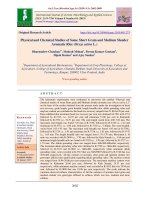
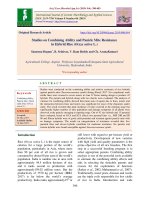


![Genetic parameters for grain yield and nutritional quality traits in foxtail millet [Setaria italica (L.) Beauv.]](https://media.store123doc.com/images/document/2020_01/13/medium_tvq1578927783.jpg)
